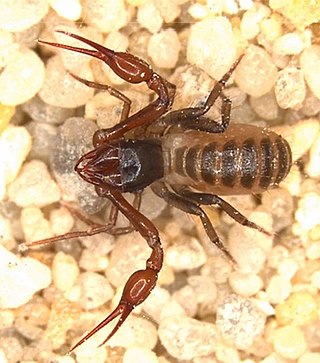
Pseudoscorpions, also known as false scorpions or book scorpions, are small, scorpion-like arachnids belonging to the order Pseudoscorpiones, also known as Pseudoscorpionida or Chelonethida.

Chthoniidae is a family of pseudoscorpions within the superfamily Chthonioidea. The family contains more than 600 species in about 30 genera. Fossil species are known from Baltic, Dominican, and Burmese amber. Chthoniidae now includes the former families Tridenchthoniidae, and Lechytiidae which has been demoted to subfamilies.

Chernetidae is a family of pseudoscorpions, first described by Anton Menge in 1855.
Synsphyronus is a genus of pseudoscorpions in the Garypidae family. It was described in 1930 by American arachnologist Joseph Conrad Chamberlin. Its distribution is mainly in Australia, but also extends to New Zealand and New Caledonia.

Garypus is a genus of pseudoscorpions in the family Garypidae. It was described by German arachnologist Ludwig Carl Christian Koch in 1873. The species are found mainly in tropical and subtropical areas, where they occupy supralittoral and littoral zones in seashore habitats.

Withiidae is a family of pseudoscorpions, first described by Joseph Conrad Chamberlin in 1931.
Austrochthonius is a genus of pseudoscorpions in the family Chthoniidae. It was described in 1929 by American arachnologist Joseph Conrad Chamberlin.
Lagynochthonius is a genus of pseudoscorpions in the family Chthoniidae. It was described in 1951 by Austrian arachnologist Max Beier.

Tyrannochthonius is a genus of pseudoscorpions in the family Chthoniidae. It was described in 1929 by American arachnologist Joseph Conrad Chamberlin.
Sathrochthonius tuena is a species of pseudoscorpion in the Chthoniidae family. It is endemic to Australia. It was described in 1962 by American arachnologist Joseph Conrad Chamberlin.

Pseudotyrannochthonius is a genus of pseudoscorpions in the family Pseudotyrannochthoniidae. It was described in 1930 by Austrian arachnologist Max Beier.
Pseudotyrannochthonius jonesi is a species of pseudoscorpion in the Pseudotyrannochthoniidae family. It is endemic to Australia. It was described in 1962 by American arachnologist Joseph Conrad Chamberlin.
Ideoblothrus is a genus of pseudoscorpions in the Syarinidae family. It was described in 1892 by Italian naturalist Luigi Balzan as a subgenus of Ideobisium.
Anagarypus is a genus of pseudoscorpions in the Garypidae family. It was described in 1930 by American arachnologist Joseph Conrad Chamberlin. Species in the genus are found on islands along the coast of northern Australia and in the Indian Ocean.
Americhernes is a genus of pseudoscorpions in the Chernetidae family. It was described in 1976 by American arachnologist William Muchmore.
Philomaoria is a genus of pseudoscorpions in the Cheliferidae family. It was described in 1931 by American arachnologist Joseph Conrad Chamberlin.
Solinus is a genus of pseudoscorpions in the Garypinidae family. It was described in 1930 by American arachnologist Joseph Conrad Chamberlin.
Xenolpium is a genus of pseudoscorpions in the Olpiidae family, with species found on various Indian Ocean islands and in Australasia. It was described in 1930 by American arachnologist Joseph Conrad Chamberlin.
Paraliochthonius is a genus of pseudoscorpions in the Chthoniidae family. It was described in 1956 by Austrian arachnologist Max Beier.

Larca is a genus of pseudoscorpions. It is the only genus in the family Larcidae. They are found in North America and Europe.







